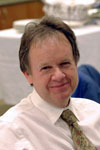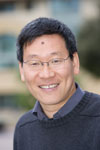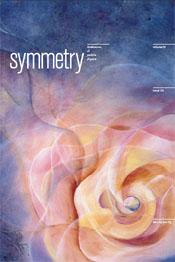

Friday - July 10, 2009
SLAC Today is
available online at:
http://today.slac.stanford.edu
In this issue:
From the Directors of Photon Science and SIMES: Planning a New Home at SLAC for SIMES
Improving Peoplesoft Financials Accessibility and User Experience
Word of the Week: Entanglement
 |
 |
|
Friday - July 10, 2009 |
From the Directors of Photon Science and SIMES: Planning a New Home at SLAC  You may have heard of the Stanford Institute for Materials and Energy Sciences, but you may not have seen many of the SIMES researchers around the SLAC campus. SIMES has had no focused footprint at SLAC. Its activities in magnetism and catalysis have been located at SSRL; its computational theory activity just started in the Central Lab; and still many researchers have offices and labs located on the Stanford main campus. That's all about to change as plans are underway to create a home and central focus for SIMES with offices and labs in the Central Lab Building 40 complex. When the renovation and construction are complete in 2011, SIMES will have a significant presence and enhanced materials science research program physically located at SLAC in Building 40. There will be a focus on materials research, a move that will bring to SLAC students, postdocs, scientific staff and faculty with expertise in materials and energy science. This is being made possible by new funding (~$8M) provided by the Department of Energy Office of Basic Energy Sciences. SIMES staff are working closely with the Facilities Department at SLAC to plan the space. Labs and offices are currently being designed to house SIMES' principle investigators, staff, postdocs and graduate students. An architectural firm will soon be engaged to begin detailed design. Construction is planned to begin by June of 2010, and SIMES hopes to have beneficial occupancy of the space by around June, 2011. Read more... Improving Peoplesoft Financials Accessibility and User ExperienceA collaborative effort is currently underway to improve the end user experience for lab wide financial transactions, through SLAC's online business system, PeopleSoft Financials. As announced in May, all SLAC staff members now have access to enter requisitions in PeopleSoft—replacing the previous Business Information System, or BIS Requisition. Please note that the BIS information System (the Purchasing Requisition component) will be phased out by end of July and being replaced by PeopleSoft. If you are unclear how to create a purchase requisition in PeopleSoft, please contact your purchasing gatekeeper. Additional information can be found in the eProcurement Requestor Center. If you are unsure who your Purchasing gatekeeper is, please contact David Pindroh (x8515). Additionally, a joint effort of Scientific Computing and Computing Services and the Office of the Chief Finance Officer is underway to improve the PeopleSoft infrastructure. The project will increase system availability and provide PeopleSoft Financials end users with better application performance. This collaborative project started in April with a planned completion date in late October. Already, users may have noticed faster application performance due to a recently completed database upgrade. The PeopleSoft updates are a part of a wider program to improve SLAC financial systems infrastructure.  The Dec 2004/Jan 2005 issue of
Symmetry magazine featured the painting
Entanglement by Dawn Neal Meson.
Word of the Week: EntanglementIn the quantum phenomenon of entanglement, two or more particles become hopelessly wrapped up in one another, their properties so closely related that they can no longer be considered individual entities. This holds true if the entangled particles are separated—determining the properties of one automatically reveals the properties of the other, even if the properties of the first are determined randomly. For an example, imagine a pair of entangled coins: In a particular entangled state, if one coin is flipped and comes up heads, the other coin must be tails or vice versa. Therefore, knowing the state of the first coin automatically determines the state of the second. This kind of entanglement is nearly impossible in larger objects, but physicists observe it in carefully prepared pairs particles all the time. A dramatic example of this phenomenon was performed in 2007 by University of Vienna physicist Anton Zeilinger, who showed that two photons remained entangled even when 144 kilometers apart. |
Events
Access (see all)
Announcements
|
|
| | ||
|
|
||
 <%
Response.AddHeader "Last-modified", getArticleDate()
'Response.AddHeader "Last-modified","Mon, 01 Sep 1997 01:03:33 GMT"
'Monday, December 06, 2010
%>
<%
Response.AddHeader "Last-modified", getArticleDate()
'Response.AddHeader "Last-modified","Mon, 01 Sep 1997 01:03:33 GMT"
'Monday, December 06, 2010
%>View online at http://today.slac.stanford.edu/. |
||